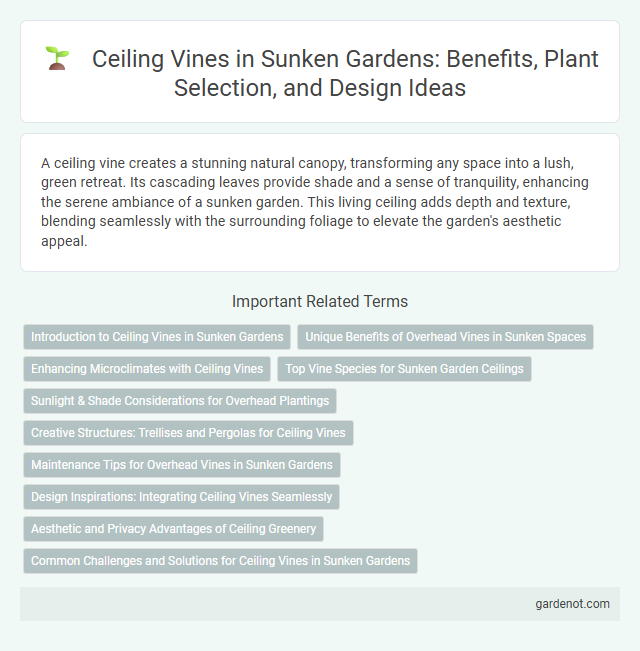A ceiling vine creates a stunning natural canopy, transforming any space into a lush, green retreat. Its cascading leaves provide shade and a sense of tranquility, enhancing the serene ambiance of a sunken garden. This living ceiling adds depth and texture, blending seamlessly with the surrounding foliage to elevate the garden's aesthetic appeal.
Introduction to Ceiling Vines in Sunken Gardens
Ceiling vines in sunken gardens create a lush, green canopy that enhances the enclosed ambiance by draping over trellises or pergolas. These vines, such as English ivy (Hedera helix) and star jasmine (Trachelospermum jasminoides), thrive in partial shade and humid conditions typical of sunken garden environments. Their dense foliage provides natural shade, improves air quality, and adds vertical interest to the garden's layered landscape design.
Unique Benefits of Overhead Vines in Sunken Spaces
Ceiling vines in sunken gardens create a natural canopy that enhances microclimate control by providing shade and reducing heat buildup, promoting a cooler environment below. These overhead vines maximize vertical space, increasing greenery without encroaching on limited floor area, which is essential in confined garden designs. The cascading foliage also adds visual depth and texture, transforming sunken spaces into immersive, tranquil retreats with improved air quality and privacy.
Enhancing Microclimates with Ceiling Vines
Ceiling vines play a crucial role in enhancing microclimates within sunken gardens by providing natural shade that reduces temperature fluctuations and retains humidity levels. Their dense foliage filters sunlight, creating a cooler, more comfortable environment conducive to diverse plant and insect life. This natural canopy also improves air circulation and moisture retention, supporting a balanced and sustainable garden ecosystem.
Top Vine Species for Sunken Garden Ceilings
Ceiling vines like English ivy (Hedera helix), Star jasmine (Trachelospermum jasminoides), and Clematis armandii are top species ideal for sunken garden ceilings due to their rapid growth, dense foliage, and ability to thrive in shaded environments. These vines provide a lush, green canopy that enhances the garden's aesthetic while offering natural shade and cooling effects. Selecting species with robust climbing abilities and low maintenance requirements ensures long-lasting coverage and vibrant seasonal interest.
Sunlight & Shade Considerations for Overhead Plantings
Ceiling vines in sunken gardens require careful sunlight and shade considerations to thrive, as they often grow overhead where light intensity varies. These plants prefer filtered sunlight or partial shade, which helps prevent leaf scorch while promoting healthy foliage. Selecting species adapted to low-light conditions ensures vibrant growth and enhances the garden's natural canopy effect.
Creative Structures: Trellises and Pergolas for Ceiling Vines
Ceiling vines transform Sunken Gardens by climbing meticulously crafted trellises and pergolas, creating a lush overhead canopy that enhances the immersive natural ambiance. These creative structures support vigorous growth, allowing vines to spread horizontally and cascade downward, producing dynamic layers of greenery. Integrating ceiling vines with architectural elements promotes shade, visual interest, and ecological benefits within confined garden spaces.
Maintenance Tips for Overhead Vines in Sunken Gardens
Ceiling vines in sunken gardens require regular pruning to prevent overgrowth and maintain airflow, ensuring healthy foliage. Consistent watering and nutrient-rich soil promote vigorous growth, while checking for pests protects the delicate overhead canopy. Supporting structures should be inspected periodically to sustain the vine's weight and prevent damage.
Design Inspirations: Integrating Ceiling Vines Seamlessly
Ceiling vines create a dynamic, nature-inspired aesthetic by cascading greenery along overhead structures, transforming sunken garden spaces into immersive, vertical sanctuaries. Utilizing lightweight trellises or wire grids allows for seamless integration of ceiling vines like English Ivy or String of Pearls, enhancing spatial depth and organic flow. Incorporating these elements supports biophilic design principles, fostering tranquility while maximizing light diffusion and air quality in enclosed garden environments.
Aesthetic and Privacy Advantages of Ceiling Greenery
Ceiling vines transform sunken gardens by creating a lush, vertical canopy that enhances aesthetic appeal with natural greenery and cascading foliage. This overhead greenery adds a sense of depth and intimacy, making the space feel more enclosed and private without the need for solid barriers. Integrating ceiling vines improves privacy by screening views from above while simultaneously softening harsh architectural lines and introducing a serene, organic atmosphere.
Common Challenges and Solutions for Ceiling Vines in Sunken Gardens
Ceiling vines in sunken gardens often face challenges such as insufficient sunlight and high humidity, which can lead to fungal diseases and weak growth. Proper pruning techniques and the installation of supportive trellises improve air circulation and structural stability, promoting healthier vine development. Using shade-tolerant species like English ivy or creeping fig also mitigates the impact of low light conditions commonly found in sunken garden ceilings.
Ceiling vine Infographic

 gardenot.com
gardenot.com